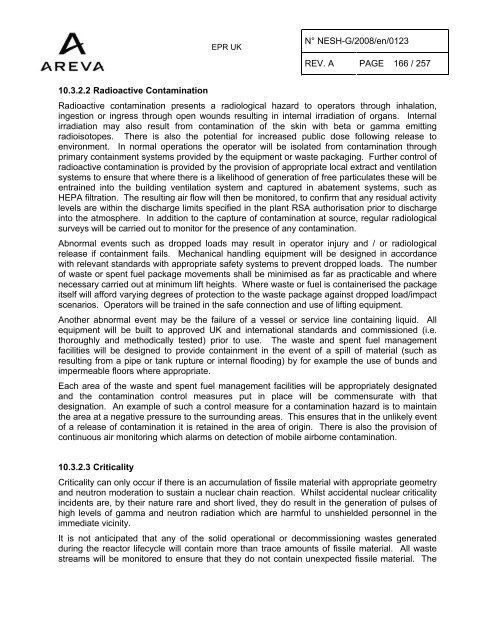Solid Radioactive Waste Strategy Report.pdf - UK EPR
Solid Radioactive Waste Strategy Report.pdf - UK EPR
Solid Radioactive Waste Strategy Report.pdf - UK EPR
You also want an ePaper? Increase the reach of your titles
YUMPU automatically turns print PDFs into web optimized ePapers that Google loves.
<strong>EPR</strong> <strong>UK</strong><br />
N° NESH-G/2008/en/0123<br />
REV. A PAGE 166 / 257<br />
10.3.2.2 <strong>Radioactive</strong> Contamination<br />
<strong>Radioactive</strong> contamination presents a radiological hazard to operators through inhalation,<br />
ingestion or ingress through open wounds resulting in internal irradiation of organs. Internal<br />
irradiation may also result from contamination of the skin with beta or gamma emitting<br />
radioisotopes. There is also the potential for increased public dose following release to<br />
environment. In normal operations the operator will be isolated from contamination through<br />
primary containment systems provided by the equipment or waste packaging. Further control of<br />
radioactive contamination is provided by the provision of appropriate local extract and ventilation<br />
systems to ensure that where there is a likelihood of generation of free particulates these will be<br />
entrained into the building ventilation system and captured in abatement systems, such as<br />
HEPA filtration. The resulting air flow will then be monitored, to confirm that any residual activity<br />
levels are within the discharge limits specified in the plant RSA authorisation prior to discharge<br />
into the atmosphere. In addition to the capture of contamination at source, regular radiological<br />
surveys will be carried out to monitor for the presence of any contamination.<br />
Abnormal events such as dropped loads may result in operator injury and / or radiological<br />
release if containment fails. Mechanical handling equipment will be designed in accordance<br />
with relevant standards with appropriate safety systems to prevent dropped loads. The number<br />
of waste or spent fuel package movements shall be minimised as far as practicable and where<br />
necessary carried out at minimum lift heights. Where waste or fuel is containerised the package<br />
itself will afford varying degrees of protection to the waste package against dropped load/impact<br />
scenarios. Operators will be trained in the safe connection and use of lifting equipment.<br />
Another abnormal event may be the failure of a vessel or service line containing liquid. All<br />
equipment will be built to approved <strong>UK</strong> and international standards and commissioned (i.e.<br />
thoroughly and methodically tested) prior to use. The waste and spent fuel management<br />
facilities will be designed to provide containment in the event of a spill of material (such as<br />
resulting from a pipe or tank rupture or internal flooding) by for example the use of bunds and<br />
impermeable floors where appropriate.<br />
Each area of the waste and spent fuel management facilities will be appropriately designated<br />
and the contamination control measures put in place will be commensurate with that<br />
designation. An example of such a control measure for a contamination hazard is to maintain<br />
the area at a negative pressure to the surrounding areas. This ensures that in the unlikely event<br />
of a release of contamination it is retained in the area of origin. There is also the provision of<br />
continuous air monitoring which alarms on detection of mobile airborne contamination.<br />
10.3.2.3 Criticality<br />
Criticality can only occur if there is an accumulation of fissile material with appropriate geometry<br />
and neutron moderation to sustain a nuclear chain reaction. Whilst accidental nuclear criticality<br />
incidents are, by their nature rare and short lived, they do result in the generation of pulses of<br />
high levels of gamma and neutron radiation which are harmful to unshielded personnel in the<br />
immediate vicinity.<br />
It is not anticipated that any of the solid operational or decommissioning wastes generated<br />
during the reactor lifecycle will contain more than trace amounts of fissile material. All waste<br />
streams will be monitored to ensure that they do not contain unexpected fissile material. The

















